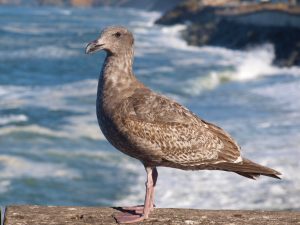
Great White Sharks— A species that is increasingly being seen, from San Diego to the Bay Area (and beyond), is great white sharks, the apex predator among sharks and one that is illegal to target or to keep if hooked accidentally (which doesn’t stop morons, knuckleheads, dunderheads, knuckle-draggers and self-proclaimed “Quints” from seeking them out.
The first report I saw of a great white at Pacifica was a message from PFIC regular Red Fish (Robert Gardner) who reported seeing a great white during the height of the salmon season in (about) 1991. Apparently the fish decided to grab a ten-pound or so salmon that an angler had hooked. Unfortunately for the angler, the shark was just a little more skillful at grabbing the salmon than the angler was at keeping it away from Mr. Sharkie.
As reported by Red Fish: “The guy moved the salmon out of the way once by moving his line. The shark made a quick, aerodynamic turn and lunged into the fisherman’s line severing the salmon from the head down. A stream of red, red blood immediately spurted across the top of the water emanating a small ring of blood. Up came a fishing line and a head of a salmon still breathing. Identification was kind of rough for me with my vision from 50 feet up where salmon look like trout.” Anglers guessed the white’s length at 12 feet and weight at 700 pounds but such guesstimates are almost always too high (and Robert guessed 9 feet as the length). Whatever the size, it must have been quite a spectacle.
Several additional sightings have been given on the PFIC Message Board over the years, a fact not unexpected considering that Pacifica’s waters are within the so-called “red triangle” area populated by great whites (Bodega Bay, north of San Francisco, out to the Farallon Islands, and south to the Big Sur region, south of Monterey).
Making the “news” in 2015 was a “cluster” of some 20 great whites that was spotted swimming together about 100 yards offshore of Pacifica’s beach. They were spotted by a Coast Guard helicopter that said most were between 10 and 15 feet long with a couple about 18 feet long. The news spread and people rushed to the pier for a look but none were hooked and they soon disappeared from the area.
On June 1, 2018, Bay Area newspapers reported that a 12-foot shark was spotted swimming under and around the Pacifica Pier. TV stations reported that it was a 12-14 foot-long shark and speculated that it was a great white shark. No one at Pacifica seemed too worried.
Red Fish also mentioned that the old Pacifica bait shop, circa early ‘90s, had pictures on its wall of what were labeled an oceanic whitetip shark (weighing approximately 250 pounds) and a large blue shark, both supposedly taken from the pier. The blue shark sounds plausible, the more tropical whitetip a little doubtful. I’ve tried to track down the pictures but to date had no luck. But who knows?
Crustaceans. While the pier today rarely sees the impressive number of fish seen in earlier years, it does yield good numbers of Dungeness crab. In fact, more Dungeness are caught at this pier than any other pier in the state.
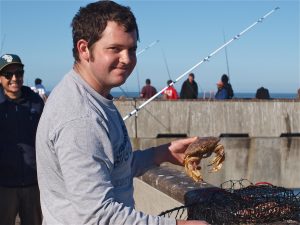
In part, this reflects the fact that it is illegal to keep Dungeness crabs caught from piers in San Francisco Bay. Rock crabs are just fine but Dungeness crabs are a no no since the Bay is considered a nursery area for Dungeness.
But, it is perfectly legal to keep Dungeness at this oceanfront pier and the pier is often jammed with crabbers seeking out the delicious crabs during the November-June Dungeness crab season—at least when the weather, tides and currents cooperate. Of course the trio do not always cooperate. Pacifica is famous for strong winds and heavy, pounding waves. One PFIC report, in November 2007 said there were 15’ waves at Pacifica and that the crabbers had gone home (although a few misguided surfers were still in the water). The next day saw huge 27-foot waves crashing over the pier and both crabbing and surfing was called off. Terra firma was just a little bit safer than the concrete pier. Big waves and crabbing do not mix.
Still, good weather and tides do not guarantee good crabbing at Pacifica. It simply means Pacifica sees more crabbers than any other pier and a sufficient number of crabs are caught to keep the people coming back.
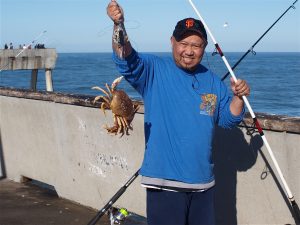
Rock crabs are also found at the pier, and can be kept year round, but Dungeness are the special crabs prized by most (although some prefer the slightly sweeter meat of the rock crabs). Crabbing does seem to have become more and more popular and at times, when the crabbers are out in force, fishing for actual fish is almost non-existent.
Fishing Tips. As at most piers, the key is deciding the type of fish you want to catch. Once you decide that the other key questions can be answered: what area to fish, what tackle to use, and what bait or lures to use? The only question that remains will be if you can find a spot on the railing.
As for myself, when I fish Pacifica I like to try for variety—some small fish quantity and some bigger fish quality. With that in mind I usually use two rods and several types of bait and riggings. One rod will be fairly light and rigged for perch; the second will be a medium action rod/reel that can be used for something a little bigger.
Perch —I have taken eight different kinds of perch at the pier and they fall into three general groups. The first group, and my favorite, is the large surfperch (redtail, calico and barred) that are found in the first third of the pier, from the breakers to about halfway out on the main stem of the pier. For all three species a high/low leader with two hooks above the sinker on short dropper leaders works best. I like to use torpedo sinkers but if the current is strong use a pyramid or triangle-type sinker that will grab the sand on the bottom. Hooks should be size 6 or 4 baitholder hooks. Use live sand crabs (if you can find them), pile worms, fresh mussels, or small pieces of shrimp or clams as bait.
I like to cast out and then retrieve SLOWLY. I do not simply sit the rod on the railing nor let the bait sit stationary in the water; fish like moving bait. Cast and retrieve, cast and retrieve, cast and retrieve. Yes, it is bait but you almost want to use it like a lure. The main problem here can be crowds and if the water is heavily covered with lines it may restrict the cast and retrieve program.
All three species may be found year round but he winter months are the best for the large surfperch. 79% of the redtail surfperch, 91% of the barred surfperch, and 67% of the calico surfperch I have taken from the pier have been caught December-February even though only 31% of my trips to the pier were during those months.
The second group of perch is the smaller schooling surfperch. Walleye, silver and spotfin surfperch provide most of this action. Although most anglers like to fish for these with bait rigs, usually Sabiki rigs, I prefer a high/low rigging with a torpedo sinker at the bottom. However I switch to size 8 or 6 baitholder hooks. Small pieces of bait finish the presentation.
The walleye seem to prefer small strips of anchovy but will also hit on pile worms or small pieces of market shrimp. The silver and spotfin seem to prefer the worm or shrimp but will also hit the anchovy. Go figure.
These perch tend to be found in the mid-level area of the water and what I do is drop the rig to the bottom and then move the bait up a couple of feet at a time. When I begin to feel bites, that’s the area I fish. Sometimes schools of walleye seem to be under schools of silvers and spotfins (but often they are mixed).
But, to be honest, some people refuse to use anything but bait rigs; they swear by them, I swear at them. They work and are easy to use. You can use a commercial six-hook bait rig like a Sabiki or Lucky Lura, or make your own leader with three or more size 8 (or smaller) hooks tied directly onto the line. Given the amount of $2-4 Sabikis seen tangled in the pilings or hanging from the pier, I would suggest making your own.
Most of the time when using a bait rig you do not need any bait on your hooks, a simple up and down jigging motion will hook the fish. However, if you sweeten a couple of the hooks with a small piece of bait, more fish may be attracted to your line. Sometimes though you need bait with the above-mentioned bait being best and, as with the high/low rig, simply drop the line to the bottom and slowly reel to the top until you find the fish.
When using pile worms or shrimp, you may also find yourself catching Pacific butterfish aka pompano. They are a small fish considered to be delicious eating. However, most are so small they seem to deserve being released.
The third group of perch is the seaperch—striped, rainbow, rubberlip, black, white and sharpnose. The first four typically are found down around the base of the pilings. Bait and tackle is similar to the first grouping of large perch (high/low, size 6 or 4 hooks, and a small torpedo sinker). Fishing for them requires care since you want to keep the rig near the mussel-covered pilings without getting snagged on the pilings. I always give it a try just to see if any of the seaperch are around but usually move on to the search for other species at some point.
White seaperch are encountered on the bottom areas away from the pier. Most are an incidental catch by those fishing “for anything” on high/low rigs baited with pile worms or pieces of shrimp.
Sharpnose seaperch are sort of an in-between species of perch sometimes caught on the bottom and sometimes caught mid-depth. A high/low rig with size 8 or 6 hooks baited with pile worms or small pieces of shrimp offer the best chance for the elusive perch that are only caught at a few piers (most in Monterey Bay).
Miscellaneous Bottom fish — Kingfish (white croaker) are the main fish landed and they are landed year round. Best rigging is a high/low rigging with size 6-4 hooks. Best bait is a small strip of piece of anchovy or mackerel, a piece of pile worm, or a strip of squid. The kingfish will often hit on the drop. Cast out, let the bait sink to the bottom, and immediately tighten the line. Often you will feel a hit as soon as the line in taunt. Strike and if the strike is missed start to slowly retrieve the line. The kingfish will often follow the bait all the way to the pier and, in fact, will often hit the bait as it begins the upward trajectory to the pier. They aren’t much in the way of “fighter class” fish but provide some action when the more sporting fish are missing in action.
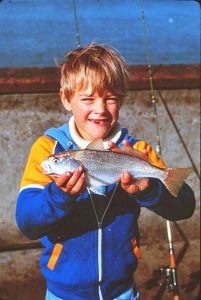
My son Mike with a kingfish (white croaker)
Everything said on the kingfish can be applied to Pacific tomcod with the exception of numbers. They are a schooling species and if the school decides to visit the pier’s waters they will be caught. But when will they visit the pier? It’s hard to say since I have caught them sporadically throughout the year with no discernible pattern.
Staghorn sculpin are another year round species and can be caught in almost the same fashion as the kingfish (although they just as soon will hit a bait resting peacefully on the bottom). If they are around, they will find your bait. Some people will switch to somewhat bigger bait when they are present but that doesn’t seem to stop them, I’ve seen the small sculpin grab baits that would barely fit in their mouths.
As for the rocky-shore species—lingcod, cabezon, greenling and rockfish; all will be caught around the pilings and the best rigging appears to be a high/low rig outfitted with size 4 or 2 hooks. Bait up with pile worms, fresh mussels, or pieces of shrimp, and fish close to the pilings on the bottom. Be careful! You must hold your rod at all times and “feel” where the bait is sitting (or being swept). You will probably still lose a rig or two but one of these nice fish is worth the effort if you can catch a legal-size fish.
Mid-water and Top-water Schooling Species — Jacksmelt can show up almost any month and since they are usually in large schools if you catch one you will probably catch more. Most will be caught on bait rigs but I prefer to use my two-hook high/low rigging. They are a hard fighting fish and one or two on a line are much more fin to catch than a half dozen fighting almost against one another.
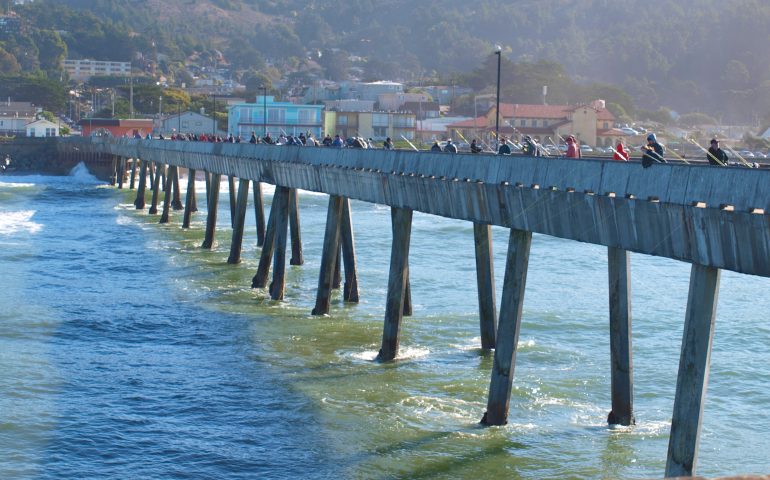
One of the best fishing pier. Got a lot salmon, stripers, perch on this pier. Go there early.
So is it safe to eat the kingfish?
In general, open-ocean areas like Pacifica have perfectly safe and delicious kingfish populations. We fished there in June and caught several large kingfish (among 9 species of fish and crabs caught) that were clean, healthy, and free of the commonly found small worms.
I enjoyed your description of fishing at Pacifica Pier and the pictures. Well done. Very interesting with lots of information.
great commentary on fishig the pier. thank you.
Would you know the length of rope needed for crabbing off of the Pacifica Pier, CA.?
jesse r king i had 100ft of rope last time i went and it was plenty.
Hi! I love this website.
A lot of people say squid on a Sabiki does not work on a sabiki, but
when I was fishing at oyster point peir I hooked an 18 – inch jacksmelt.
My girlfriend and I went to Pacifica Pier on April 3, 2021. We didn’t see a lot of people on the pier. We walked along the pier and stopped just short of the end before turning around and heading back. We did see a man bringing in his catch of the day through using a small boat he pulled up on the beach. We continued our walk just beyond the beginning of pier and eventually headed back to the car.
After the superficial damAge this past January The city closed the entire pier and was debating weather to close the pier permanently. They refused my calls to partially open it claiming it could collapse even though no expert said that.
And they refused to repair it. So I got the California Coastal Commission (CCC) involved around March 15 2021 who said the city can’t deprive the public of access without a permit from them. They immediately had the city partially open it and are now overseeing the city’s repairs which are moving very slowly because the city is crying poor even though the want to spend 12 million dollars on a new city hall.
Good to know that the CCC has jurisdiction over the piers
Thank you for your efforts on the pier.
The pier is in disrepair. The end is blocked off and is falling apart. Sad.. needs restoration!!
Started fishing here in 1985 I was 5 saw many things on that pier and in the water. A Great white shark swimming under the pier. Caught thresher sharks, hooked and lost blue sharks, caught salmon, and stripers, saw 40 pounder king salmon getting caught there. Old Cecil selling his undersized anchovies at international point. Watching mute Ron cast the 8 oz pyramid on international point father than anyone I’ve seen. Caught small shiners, pompano, smelt, king fish (croaker) jigged for sardines and anchovies, caught dungeness, red and rock crabs, countless bullheads piled up on the corners because nobody wanted them but great as striper bait in the carquinez! Halibut, I seen one giant sea bass caught. Seen many salmon stolen by sea lions while the og fisherman tried to hand line them in the pier when the crab net was too slow to be dropped to scoop up the fish. Pulled many bobbers and fish from the pickings during the 95 salmon run when nobody cared to retrieve there set ups. Many memories. Lots of bbgs, fights, and card playing (Pusoy) seeing bud drunk as hell but finding a way to still catch fish. Many familiar faces but never really knew names. Rudy and his son marcel. The ogs on that pier I thank my father Arnulfo Sarmiento for teaching me how to fish me and my brother Joshua. It’s sad that the pier doesn’t have the salmon fishermen anymore and now it’s just the crab snaring crowd but I don’t hate I know the salmon are there but nobody try’s because nobody knows how to fish the top and the bottom of that water for them anymore. It is the best fishing pier in California and maybe one of the best in The U.s.a
Paul, Thanks for the report. I spent many a day there back in the mid to late ’70s when I lived in the Bay Area. Later, after moving north, there were far less visits but it’s still a favorite pier to visit when I am in the area. Ken
For Paul Sarmiento… a bit of instruction on how to catch Salmon off the pier would be appreiated.
In a fairly suburban area like we live in….Pacifica still has a great getaway Beach feel to it.
As I slide into my 80’s, my wife and I still like to to walk Pacifica and I always learn something
every time I fish; even to walk the pier and ask “what’s running”.